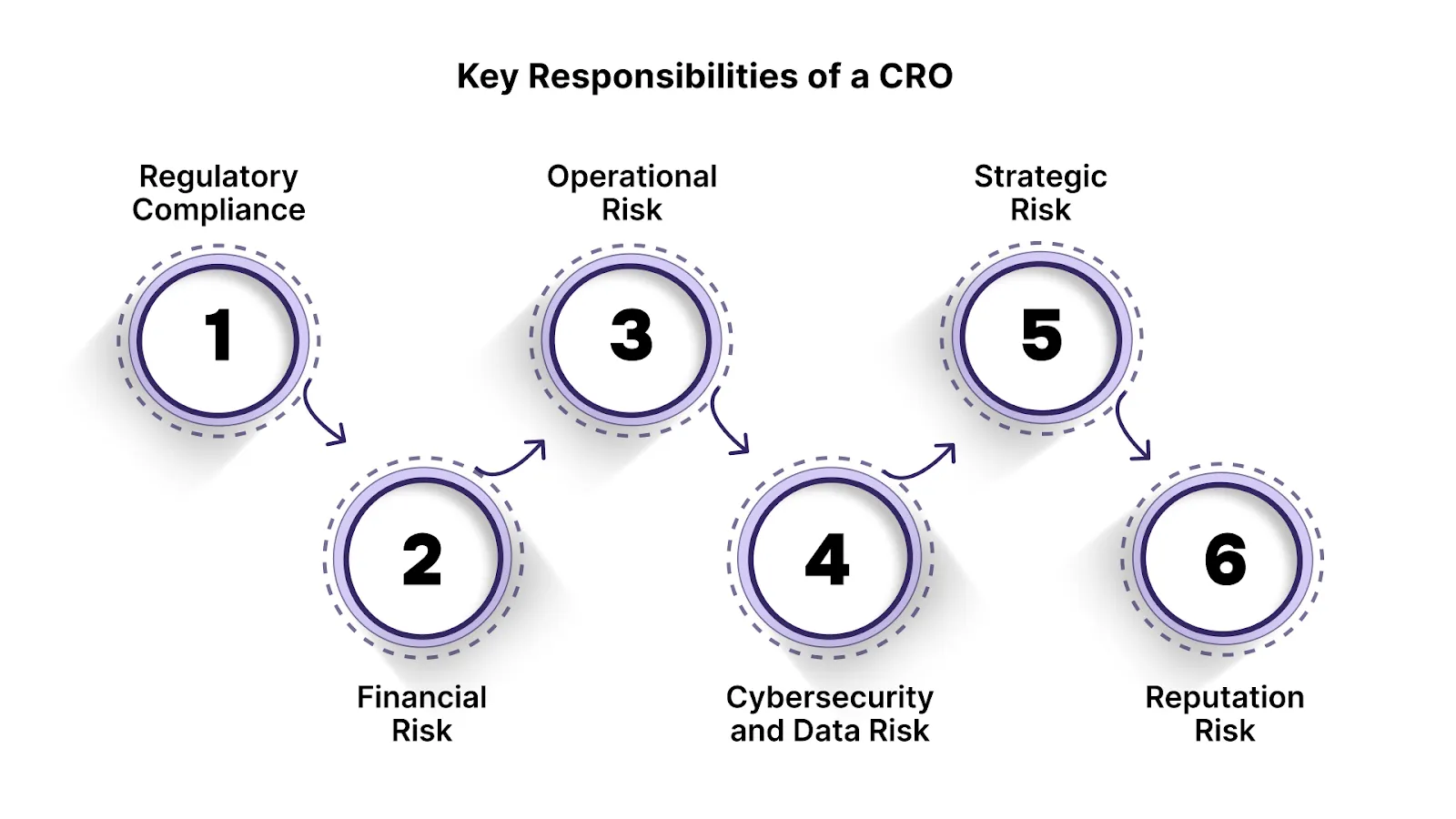Oct 8, 2025
Chief Risk Officer (CRO): Key Role and Responsibilities

By Fraxtional LLC
%20Key%20Role%20and%20Responsibilities.webp)
Have you ever wondered how much U.S. companies paid in enforcement fines when risk controls failed? In 2024, U.S. regulators imposed over $8.2 billion in penalties, driven by cases of financial law violations and gaps in compliance.
A Chief Risk Officer (CRO) is the person expected to catch these dangers before they become crises. For businesses building new financial products, expanding across states, handling stablecoins, or applying for money transmitter licenses, risk isn’t abstract; it can mean delayed launches, unexpected fines, or losing trust.
This article explains what a CRO does, key skills, and how budget-conscious or fast-growing companies can quickly establish risk leadership.
Quick Overview
- The Chief Risk Officer (CRO) is responsible for identifying, assessing, and managing risks that could impact an organization's financial, operational, and regulatory stability.
- Key CRO duties include developing risk frameworks, ensuring compliance with evolving regulations, and reporting risks to the board and regulators.
- CROs address various types of risk, such as financial, operational, cybersecurity, and reputation, helping companies avoid costly mistakes and stay on track.
- Successful CROs have regulatory expertise, strategic thinking, and communication skills to manage risks and support growth.
What Is a Chief Risk Officer?
A Chief Risk Officer (CRO) is the senior executive responsible for protecting your organization against financial, compliance, and operational risks. Their role is to identify, assess, and manage potential threats that could disrupt business growth or invite regulatory scrutiny. By guiding leadership with structured risk strategies, they help you balance innovation with stability in highly monitored markets.
The CRO’s role is integral to keeping a business secure. But how exactly do they make an impact? Let’s break down the core duties they manage daily to prevent risks from derailing operations.
What Does a Chief Risk Officer Do?

Without proper oversight, businesses face significant risks, including regulatory fines, compliance breaches, financial losses, and operational disruptions.
A Chief Risk Officer (CRO) addresses the challenges by identifying potential threats, building strategies to minimize impact, and ensuring compliance with evolving regulations. By protecting the organization from setbacks and aligning risk management with business goals, the CRO enables sustainable growth with greater confidence and stability.
Here are the core responsibilities you can expect a CRO to handle to keep your business secure and aligned with objectives:
- Build and oversee risk management frameworks: Develop structured processes to identify, assess, and manage risks across all operations.
- Monitor regulatory changes and ensure compliance: Stay updated on laws and guidelines, ensuring your company meets all required standards.
- Align risk strategy with business objectives: Integrate risk considerations into decision-making, supporting growth while reducing exposure to potential losses.
- Report risks to the board and regulators: Communicate key risk areas and mitigation plans to leadership and regulatory authorities.
- Oversee cross-functional risk areas (financial, operational, cyber, AML, licensing): Manage risk across departments to maintain comprehensive protection and regulatory alignment.
The CRO’s responsibilities span a wide range, but let’s look deeper into each area of focus.
With Fraxtional's on-demand CRO services, you can access expert risk leadership to guide your compliance and strategy without the need for a full-time hire.
Key Responsibilities of a CRO

A Chief Risk Officer manages the risks that can directly affect an organization's growth, regulatory standing, and financial stability. Their role is critical for companies navigating complex compliance rules, money transmitter licensing, or banking partnerships while expanding across multiple jurisdictions.
By guiding leadership through these challenges, a CRO ensures business decisions do not expose the company to unnecessary fines or operational delays.
1. Regulatory Compliance
A CRO ensures your operations meet standards such as AML, BSA, and state licensing requirements, helping you avoid costly enforcement actions.
For example, a fintech handling cross-state transactions relies on the CRO to verify licenses and reporting obligations are in place before launching new products. They also implement training programs and internal audits so your team consistently follows regulatory updates, reducing the chance of violations.
2. Financial Risk
Market volatility, liquidity pressures, and transactional exposures can quickly threaten small or mid-size companies. A CRO analyzes these risks, advises on hedging strategies, and ensures operational capital is sufficient to handle unexpected financial changes.
For instance, a crypto startup issuing stablecoins benefits from a CRO monitoring market fluctuations and liquidity to prevent solvency or investor confidence issues.
3. Operational Risk
Process gaps, human error, or fraud can disrupt scaling for startups and smaller firms. A CRO identifies vulnerabilities, establishes internal controls, and oversees audits to keep operations running smoothly.
As an example, a company expanding banking partnerships might rely on the CRO to prevent duplicate payments or compliance gaps that could delay service rollout.
4. Cybersecurity and Data Risk
Handling sensitive customer or transactional data is critical for digital asset firms and fintech operations. A CRO works with IT teams to monitor systems, enforce policies, and respond to incidents quickly to maintain compliance and trust.
For example, a payments platform storing client financial data depends on a CRO to prevent unauthorized access that could result in regulatory scrutiny or client loss.
5. Strategic Risk
CROs help balance aggressive growth with regulatory and operational realities. They evaluate new business initiatives, flag exposures, and guide leadership on decisions that support expansion safely.
For instance, a startup entering multiple markets relies on a CRO to weigh regulatory hurdles and advise on phased launches to avoid costly delays.
6. Reputation Risk
Regulatory missteps or public failures can damage credibility with banks, investors, and customers. A CRO monitors potential threats, prepares response plans, and coordinates communications to maintain trust.
For example, a company facing a licensing delay can rely on a CRO to manage stakeholder expectations and maintain strategic relationships while resolving the issue.
Beyond reputation, the question remains: who does a CRO report to, and how do they communicate these risks to leadership? Let’s clarify that next.
Also read: Is an Outsourced Chief Compliance Officer Right for You?
Who Does The Chief Risk Officer Report To?

A Chief Risk Officer maintains direct communication with top leadership to ensure risk management aligns with business priorities and regulatory obligations. Here is how reporting typically works in structured organizations:
- CEO: Provides regular updates on operational, financial, and compliance risks that could impact strategic decisions.
- Board of Directors: Reports key risk exposures, mitigation strategies, and regulatory compliance status to guide oversight and governance.
- Audit or Risk Committees: Shares detailed findings from audits, risk assessments, and internal controls to ensure transparency and accountability.
- Other Executives: Collaborates with department heads to communicate emerging risks and coordinate mitigation plans across the organization.
Sustaining this governance cadence demands the right competencies; the next section covers the essential skills behind top-performing CROs.
Essential Skills of a CRO

A Chief Risk Officer needs a combination of technical expertise and interpersonal skills to manage risks while supporting growth effectively. Here are the essential skills a CRO brings to protect your business and guide critical decisions:
- Regulatory Knowledge: Understand complex requirements such as AML, money transmitter licensing, SOC 2, and fintech-specific regulations to ensure full compliance.
- Analytical and Strategic Thinking: Assess financial, operational, and market risks, and develop strategies that align risk management with business objectives.
- Communication and Stakeholder Management: Clearly convey risk findings and mitigation plans to executives, boards, regulators, and internal teams to maintain alignment.
- Tech and Data Literacy: Utilize risk management tools, data analytics, and automation solutions to monitor, predict, and address emerging risks efficiently.
But even the best-prepared leaders face challenges. Let's take a look at some of the hurdles CROs encounter in their role.
Also read: Chief Compliance Officer: Key Responsibilities, Challenges & Business Impact
Challenges CROs Face Today

CROs face unique challenges when managing risks in fast-growing and highly regulated environments, particularly for businesses expanding across multiple jurisdictions.
A surge in entrepreneurship amplifies these pressures. In 2024, the U.S. averaged about 430,000 new business applications per month. Roughly 50% more than in 2019, forcing CROs to support breakneck growth while keeping compliance and risk in check.
Here are the common challenges CROs encounter that directly impact:
- Balancing Innovation and Regulation: Support rapid product development and market expansion while ensuring compliance with AML, licensing, and fintech regulations.
- Managing Multi-Jurisdictional Compliance: Operating across states or countries introduces different rules and reporting requirements, requiring careful coordination to avoid fines or delays.
- Building a Risk Culture: Startups at seed or Series A stages often lack formal processes, making it challenging to instill consistent risk awareness and accountability across teams.
- Limited Resources: Smaller businesses often have constrained budgets, meaning CROs must deliver comprehensive risk oversight without large compliance teams or dedicated technology.
With that in mind, what if a company needs risk leadership but doesn't yet have the budget for a full-time CRO? We'll take a closer look at how Fraxtional's services can provide an effective solution.
Also read: When to Hire a Fractional Compliance Officer
Get Tailored Risk Leadership with Fraxtional’s CRO Services

Managing complex risks and regulatory compliance can be overwhelming without experienced leadership guiding every decision. Fraxtional provides fractional Chief Risk Officers and risk experts to help you address the same challenges discussed above:
- Fractional CRO Services: Access on-demand Chief Risk Officers who identify, assess, and manage financial, operational, and regulatory risks.
- Risk Strategy & Oversight: Build risk frameworks, monitor compliance changes, and align risk strategy with your business goals.
- Operational and Regulatory Support: Handle AML, BSA, licensing, and multi-jurisdictional requirements without hiring a full-time executive.
- Audit and Risk Assessment: Conduct independent audits, regulatory gap analyses, and actionable risk mitigation plans tailored to your business.
- Strategic Guidance for Growth: Ensure your expansion initiatives stay compliant and sustainable while protecting your company’s financial health.
Conclusion
Understanding the Chief Risk Officer role shows how a CRO protects business growth, finances, and compliance. By defining key responsibilities like regulatory adherence, risk management, and strategic support, companies reduce costly risks. Implementing strong risk frameworks leads to smoother operations, better investor confidence, and long-term growth in regulated industries.
Fraxtional offers fractional CRO services designed for fintech, crypto startups, and high-growth companies. With on-demand CRO expertise, your business receives guidance on compliance, licensing, and risk strategy. Partnering with Fraxtional ensures your business remains compliant, scales confidently, and manages risks across operational and regulatory areas.
Empower your organization with Fraxtional’s CRO expertise and safeguard your business against regulatory and operational risks. Reach out now!
FAQs
The Chief Risk Officer (CRO) is responsible for identifying, assessing, and mitigating risks within an organization. They oversee risk management strategies to protect the company’s assets and reputation.
A CRO typically holds a degree in finance, economics, or business, often with an MBA or advanced certification in risk management. Extensive experience in risk assessment, leadership, and industry-specific knowledge is also essential.
The CRO role is highly prestigious and offers strong career growth, particularly in sectors like finance, insurance, and consulting. It provides a chance to have a strategic impact on the organization’s success by managing risk effectively.
To be a Chief Risk Officer, candidates generally need a background in business, finance, or economics, often supplemented with risk management certifications. Years of experience in senior management roles and expertise in the specific industry are also crucial.
The 3 C’s of risk are Clarity, Communication, and Collaboration. These principles guide effective risk management by ensuring that risks are clearly identified, communicated to stakeholders, and managed through collective efforts.
The highest salary for a risk manager can vary by industry and location but can range from $150,000 to over $300,000 annually. In top companies or financial sectors, the salary can exceed these figures, depending on the role’s seniority and scope.
blogs
Don’t miss these
Let’s Get Started
Ready to Strengthen Your Compliance Program?
Take the next step towards expert compliance solutions. Connect with us today.




